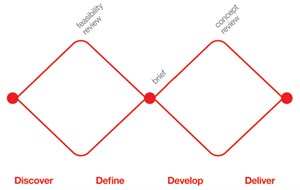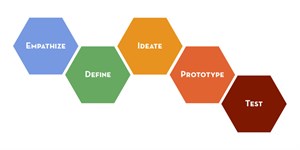Theory, method and process
Jo Bailey
January 2014
Section summary
- User-centred design (UCD) requires getting the end users involved in the process.
- Design thinking is an articulation of an iterative UCD process incorporating empathy building, iteration, prototyping, testing and reflection.
- LAWA utilised UCD and design thinking tools, but sometimes constraints meant working pragmatically without user feedback.
- Design has values that differ to science and engineering, but still has a robust methodology.
- By asking ‘stupid questions’, gaps in process or design output can be identified.
The LAWA process has been informed by principles of user-centred design, and largely mirrors existing design methods often grouped as design thinking.
User-centred design
User-centred design (UCD, also known as human-centred design) is a “broad term to describe design processes in which end users influence how a design takes shape” (Abras, Maloney-Krichmar, & Preece, 2004). It is a key method used within user experience design (UXD). User-centred design principles include requirements that:
– The design is based upon an explicit understanding of users, tasks and environments.
– Users are involved throughout design and development.
– The design is driven and refined by user-centred evaluation.
– The process is iterative.
– The design addresses the whole user experience.
– The design team includes multidisciplinary skills and perspectives.
Design thinking
Design thinking as a term evolved out of research that sought to define the processes and approaches designers (as distinct from scientists or engineers (Cross, 2011)) use to solve problems.
In 1969 Herbert Simon defined design as “transformation of existing conditions into preferred ones” (Simon, 1969), linking design to the idea of a better future. He outlined a process of ‘Define, Research, Ideate, Prototype, Choose, Implement, Learn’ as an articulation of design thinking, and this remains the foundation of frameworks defined since, such as “Discover, Define, Develop and Deliver” (Design Council, 2005) or “Empathise, Define, Ideate, Prototype, Test” (Stanford d.school, n.d.).
Design thinking encompasses UCD, and other tools such as collaboration and prototyping. It has increasingly found favour within business schools as it encourages a lean “fail fast, fail cheap, fail early”, or “learn fast, learn cheap, learn early” (Mootee, 2013) approach.
|
|
 |
D.School and Design Council’s design processes
The science of design
Nigel Cross classifies the values of scientific culture as “objectivity, rationality, neutrality, and a concern for ‘truth’” and design’s as “practicality, ingenuity, empathy, and a concern for ‘appropriateness’” (Cross, 1982 p.222). Within LAWA’s multidisciplinary team, being conscious of these differences, especially at moments where design and science seemed to be speaking different languages, aided negotiation of sticking points. Cross’s research assisted me in articulating what we do as a method with its own kind of rigour, albeit not one based on the scientific method.
Another design method: the power of the ‘stupid question’
Designers often attempt to solve problems about which they know nothing. I have also come to believe that in such ignorance lies great power: The ability to ask stupid questions.
(Norman, 2013)
Toyota originated the ‘Five Whys’ (Ohno, 2006) as a way to get to the root of a design problem, andDon Norman (2013) categorises asking ‘stupid questions’ as part of a design thinking approach.
In previous projects, I had been reluctant to ask what I felt could be perceived as 'stupid questions', instead keeping my ignorance quiet and taking circuitous journeys to acquire answers retrospectively. In the LAWA project, that was not always feasible. I discovered that, more often than not, my questions did not have simple answers, or that I did not understand because there was an error in the information presented. Asking questions demonstrated how much prior knowledge was being taken for granted by the scientists – an issue that many lay users would also have found confusing. The process demonstrated that using ignorance consciously locates gaps, and the outcome is better as a result.
Challenges
Within LAWA, the clients represented a small subset of the potential users, so could not fully reflect all groups. We needed to justify spending time to understand what potential users wanted to get out of LAWA before we could properly define the scope, let alone the design. UCD was, in reality, an ambition, utilised as much as possible in terms of time and budget, but supplemented pragmatically with self-design, genius design, and activity-focused design.
Ethical Considerations
UCD fallacy
There was not as much direct user engagement as I would have liked in LAWA, yet when talking about the project to clients, it is from the perspective of it having been built using a user-centred approach. This is not untrue, but equally UCD did not extend as far as I would have liked.
Only me…
Having advocated for UCD and design thinking – both of which emphasise prototyping and testing – I have to admit, I have done no user testing with Making Good. In fact, you are the test phase. Sorry I didn’t get ethics approval!



